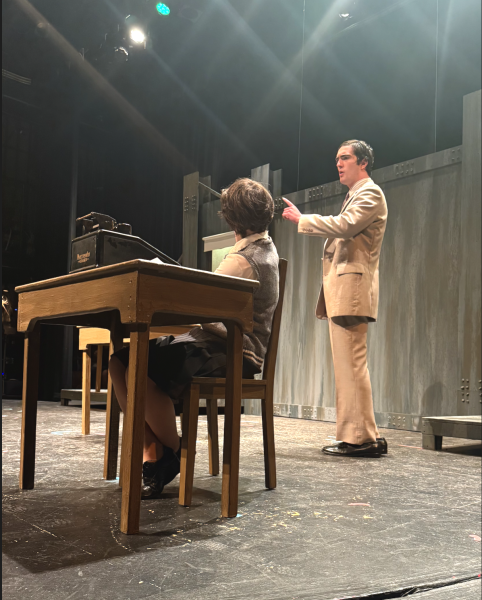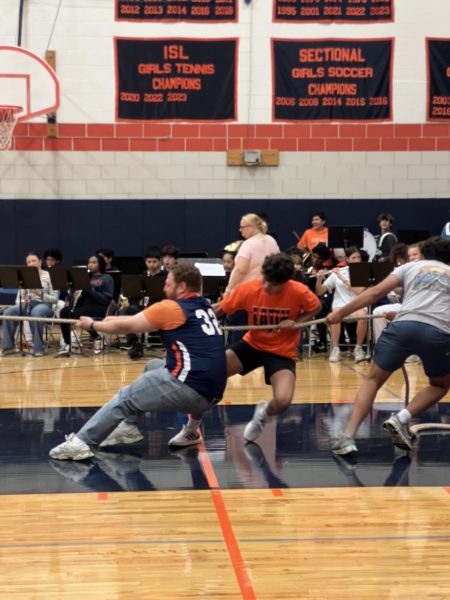Are We Running Out of Space? Questions Arise as Class Sizes Grow
Latin students pack closely together in the Upper School Learning Commons.
One hundred thirty-five freshmen entered Latin’s Upper School on August 29—five more than the class of 2026, 10 more than the class of 2025, and 12 more than the class of 2024. With these continuous increases, some community members have raised concerns about the changing shape of Latin’s academic ideals.
These figures may seem like mere statistics, but this pattern is already having material consequences. “We’re not always aware of how little changes with just a few extra students can have an impact,” Upper School librarian and Latin School Union (LSU) representative Gretchen Metzler said.
For one, the increased student population raises concerns about faculty obligations. Upper School math teacher and LSU treasurer Chris van Benthuysen said, “Either your average class size is going to go up, or you’re going to have to start adding teachers, or at least adding sections.” With more sections or higher average class sizes, many teachers would be required to take on larger caseloads.
If Latin encounters this issue, there is a possibility that the newly finalized Collective Bargaining Agreement (CBA) might be impacted. Should student numbers increase further, the caseloads agreed upon in the CBA could potentially become untenable, resulting in the school needing to hire more teachers and increase its spending.
This reality creates a financial tug-of-war: While more students and families could contribute to community funding, the long-term profitability of this change is unclear. “We probably don’t want to grow super incrementally—like three students every year over the course of 10 years,” Mr. van Benthuysen said. “Somewhere in there you suddenly get walloped with ‘we need to hire one more teacher in every single department.’”
However, even with current trends, Latin’s classes are still smaller than many of its counterparts. “I’m coming from a school where I regularly had classes as large as 30 and rarely had classes smaller than 20 to 24,” US English teacher Zachary Duffy said. “For me, everything still feels not only manageable, but sort of nice.”
While Latin’s growing class sizes may seem worrying when viewed in a vacuum, it’s notable that the school has no problem reaching full enrollment. Chicago Public Schools, for example, have seen a 10 percent decline in enrollment between 2019 and 2022. This decline is attributed to factors such as mounting costs of living and the popularity of selective schools among wealthier groups—thus lowering the anticipated state funds given to public education programs by around $4.7 million.
Ultimately, comparing factors such as test results and census responses from schools of varied sizes across the nation shows that the sheer number of students does not affect the caliber of a high school education so much as a school’s preparedness to accommodate them.
Latin’s facilities team says that productively utilizing the school’s space continues to be a priority. “I think for the programs Latin has in place, the school is being efficiently used,” Director of Operations Chanel King said. “One of the best things about Latin is our ability to adapt to change. If there is a huge uptick in the student population, we will immediately plan to prevent a shortage in space, but that is not something that we are concerned about at current (or even increased) enrollment numbers.”
Yet space is still a concern among faculty, especially when it comes to classroom capacity. “Many of the classrooms are built to be quite small and intimate, with 12 students in mind,” Ms. Metzler said.
Upper School history teacher Kristin Gulinski said, “When you think about legal requirements [and] code requirements, there’s only so many students you can have, for safety reasons, in a classroom.”
When considering the Wrigley Theater, Latin is already pushing against these bounds. With students sitting in the aisles and on folding chairs, the space is stretched considerably thin. At a gathering with everyone in attendance, the theater would hold 513 Upper School students, 62 advisors, two deans, and one director. This makes 578 people—even assuming no other adults in attendance. However, according to fire regulations, the lower part of the theater can legally hold only 324 people, with the upper level even lower at a 250 maximum, putting the legal capacity of the theater at 574. In other words, if attended in full, some of Latin’s community events could be stretching fire safety regulations by a margin of about four people.
Despite these statistics, administrators are adamant that Latin’s student population is still within its desired range. “Latin usually enrolls around 1,190 students each year,” Ms. King said. “We are still hovering around this number and are a long way from being at building capacity. We keep classroom sizes fairly small because that is part of Latin’s teaching philosophy, but from an emergency standpoint, none of the protocols are impacted by small increases in enrollment.”
While the admissions office declined to comment after multiple points of contact, Chief Financial Officer Michael Szczepanek agreed with Ms. King, saying, “The target enrollment across Latin is 1,190. At the start of the school year, we reported 1,196. In any given year, we may be slightly above or below target, and we factor [in] this uncertainty when establishing a budget.”
Even when considering these flexible figures, monetary gain may be a factor for rising student populations. Namely, with any rise, as Mr. van Benthuysen said, “[Latin will] inch [its] way up in tuition revenue.”
This fact isn’t necessarily viewed with resentment—many Latin community members sympathize with the financial incentive for the school to increase its number of students. “I understand the need to increase class sizes as much as possible so that we can handle increasing budget demands,” Mr. Duffy said.
Regardless, many believe that Latin’s small class sizes are part of its appeal to parents. “I know Latin has relatively small class sizes even amongst our independent school peers. That would seem to me, as a parent, probably like a pretty big draw for the school,” Mr. Duffy added.
These competing interests raise a considerable challenge. Ms. Metzler said, “I can’t imagine that that’s going to be comfortable if sizes continue to grow, or attractive to folks who are new to Latin—to be able to see that these classrooms are small, and their kid is sitting in a folding chair in the theater.”
Further, budgets and marketing are not the only issues at stake. “The bigger the school, the harder it is for us to know each other,” Ms. Metzler said.
Echoing these concerns, Ms. Gulinski said, “When you have fewer students in a classroom, [student-teacher] relationships can grow much better, [and] it is very noticeable that our class rosters are at capacity.”
If this uptick remains consistent, some feel these increases could end up decreasing Latin’s quality of education and hurting its core philosophy. “I think it’s great that the school is providing opportunities for students and trying to increase enrollment,” Ms. Gulinski said, “but at the same time, [a balance] of quantity of teachers [and] class-student ratio size is still critical to maintain if you want the quality of education to be the same.”
This tradeoff captures the fundamental struggle of Latin’s larger class sizes: Ms. Metzler said, “Every body brings one less chair available.”

Scarlet Gitelson (‘26) is delighted to be serving as one of this year’s Editors-in-Chief. Using her writing, she seeks to promote connection and discourse...

Lyla Granich (‘26) is honored to serve as one of the Editors-in-Chief this year. Through tending to the school's cultural body, she hopes to present...






















































Frank Schneider • Sep 27, 2023 at 10:22 am
The theatre is actually 324 people on the main floor (which is the number of seats). The occupancy card clearly states Auditorium mani floor. The balcony is 250, which is carded for room 227 upper. So really every time we gather, not just when everyone is there, we are breaking the fire code. If there are more bodies than seats on the main floor we are breaking the fire code occupancy limit.
Mr. McArthur • Sep 19, 2023 at 7:41 am
Good and important article! I have similar feelings to Mr. Duffy having grown up in large public schools with 30+ kids in all of my classes — Latin has terrific learning environments where teachers and students can get to know each other well because of the much smaller class sizes. That said, my freshmen algebra classes the last two years feel like night and day. Last year I had only 13 students and had a TA to help out most days. This year I have 17 students and no TA. There’s a significant difference already in how much I can interact with every student.